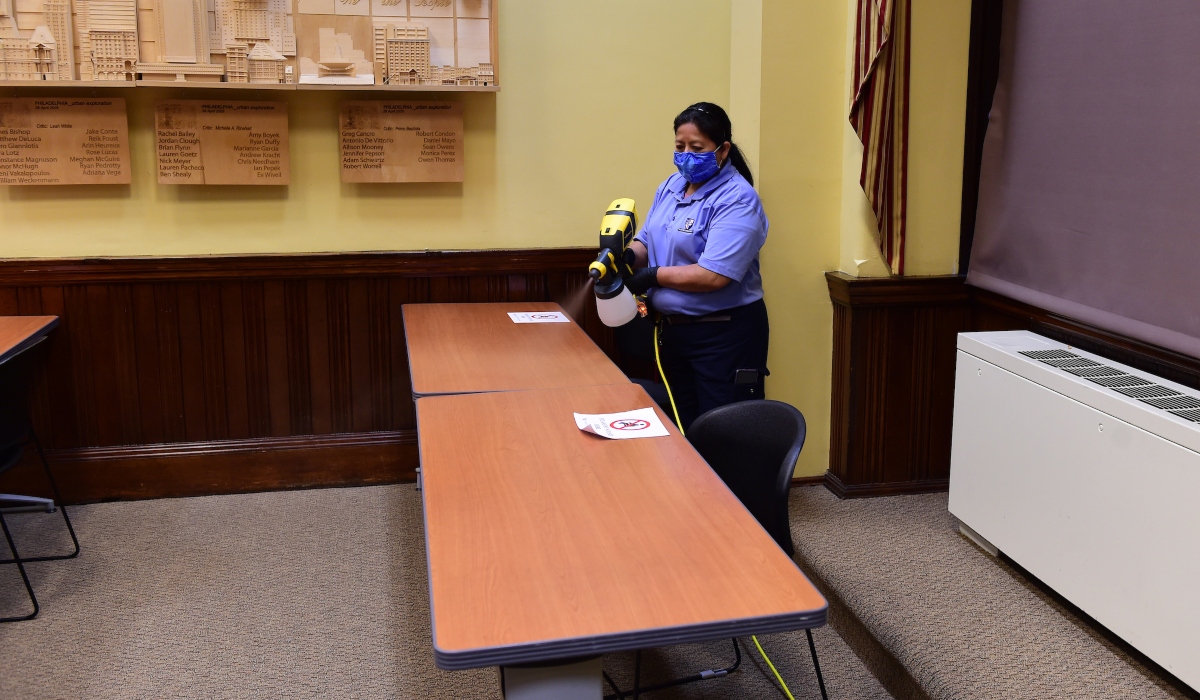Keep Catholic Safe – Facilities Preparations
The Facilities team continues to closely monitor the evolving guidance of the DC Department of Health, the Centers for Disease Control (CDC), and industry and professional organizations. Vaccination, face coverings, hygiene, surface cleaning, and physical distancing where possible, are the most effective tools for risk mitigation. The University’s Keep Catholic Safe Plan includes all of these actions to reduce the risk of virus transmission.
Building Environments and Indoor Air Quality
The Facilities team evaluated building systems and indoor air quality conditions in all campus buildings with the support of consulting architects and engineers in the Summer of 2020. Based on their recommendations, improvements have been implemented, where feasible, that may further reduce transmission risk.
Mechanical Ventilation: Increasing ventilation with outdoor air, optimizing air exchange rates, and improving air filtration are among the industry recommendations the may mitigate the risk of airborne spread. These must be carefully balanced so that employing one improvement does not counteract with another. The University has implemented both permanent and interim engineered improvements to classrooms and assembly spaces on campus, where feasible. These mitigations, aimed at improving ventilation and filtration, vary by building but may include: provision of additional outside air; keeping systems running longer than normal; upgrading system filters to the highest grade compatible with the existing equipment; and the deployment of mobile, self-contained filtration units.
Natural Ventilation: According to the CDC and other sources, the opening of windows and doors to allow natural ventilation into the specific spaces may help under certain conditions. This statement is caveated by the need to balance other potential risks. Several buildings on campus have operable windows that may be opened to allow fresh air to directly ventilate the associated space. However, open windows in public spaces introduce uncontrolled airflow and other environmental conditions, such as moisture accumulation and freezing conditions in winter months. Additionally, open windows introduce uncontrolled wind gusts with random patterns of turbulent air distribution. Mechanically ventilated spaces provide more stable airflows and direct air in a more controlled manner. Nonetheless, partial opening of windows during temperate and mild outdoor weather conditions may be considered as a means of introducing additional outside air. This is most easily implemented in private offices.
Modifications to our HVAC systems, maintenance procedures, and operations are considered additional layers of a larger strategy that includes these essential fundamentals: encouraging vaccination, wearing face coverings, increased surface cleaning, frequent hand washing, and social distancing where possible.
Cleaning
An emphasis on sanitizing high-touch areas across the University has become standard operating procedure. Most cleaning will be done during the overnight hours.
- Academic and administrative facilities, including classrooms, will be cleaned and sanitized nightly. Offices will be cleaned weekly.
- Residential Facilities will be cleaned and sanitized daily. Residential rooms, suites, and apartments are supplied with a disinfectant cleaning solution and cloth.
- Portable germicidal ultraviolet (GUV) units that emit UVC lights are in use at various locations throughout the campus (athletics, health services, a few academic units such as labs and performance spaces).
- Wall-mounted and stanchion hand sanitizers are everywhere on campus.
- Disinfectant stations are located in common areas in academic, administrative, special-use facilities, and residential common kitchens. The supplies are to be shared among the area/unit’s occupants. Return cleaning supplies to the station when you are done using them.
Additional Measures for Classroom Safety
Mobile, plexiglass barriers are available for faculty who want to teach behind a physical barrier. Face shields are also available.
Updated Aug. 24, 2021

